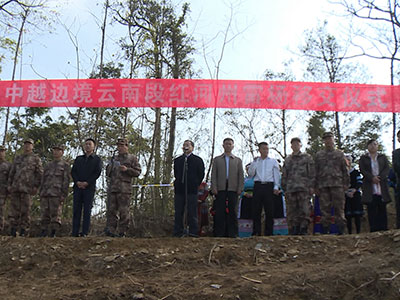
CCTV News:After more than eight months’ fighting, 18 minefields in Honghe Prefecture, Yunnan Province were successfully eliminated, and the 4.436 square kilometers "dead zone" was transformed into a "land of peace". On the morning of the 9th, more than 150 officers and men of the Mine Clearance Command of Yunnan Military Region, leaders of relevant military departments of Yunnan Province and representatives of the people in the minefield came to Bozhuqing minefield to hold the handover ceremony of Honghe minefield in Yunnan section of the Sino-Vietnamese border.
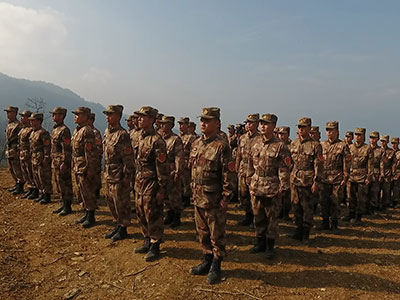
At 11 am, the handover ceremony began. The Bozhuqing minefield is 20 kilometers away from Qiaotou Township, Hekou County, Honghe Prefecture, Yunnan Province, with an area of 0.15 square kilometers. It is one of the last minefields excluded in Honghe Prefecture. According to the leader of the mine-clearing headquarters, more than 70 officers and men of the second mine-clearing team were ordered to go to the border minefield of Honghe Prefecture, and moved to Luchun County, Jinping County and Hekou County, and conquered the dangerous areas with great difficulty in mine clearance, such as the "Laoyonghoushan" minefield, the "Maqihoushan" minefield, the 1076 minefield and the old Karechang minefield. Because there are many minefields in Honghe Prefecture, the lines are long and scattered, officers and men have to set up tents outside the minefield to live temporarily.
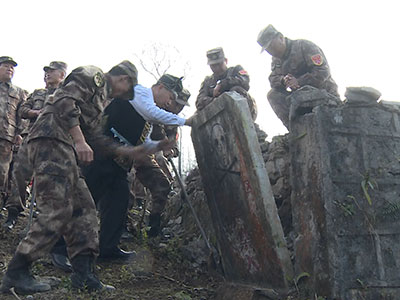
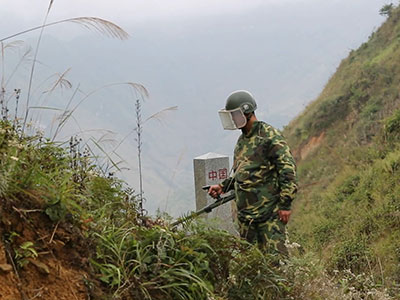
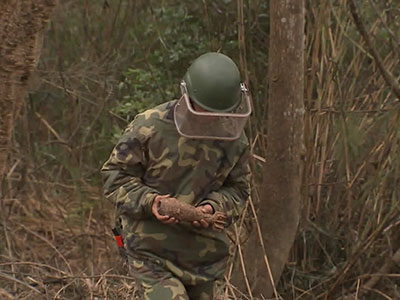
At the ceremony, the officers and men of the mine-clearing unit conducted inspection in the unique way of China soldiers, which was the most striking acceptance on foot at the handover ceremony. At 11: 20 a.m., nearly 100 officers and men from the mine-clearing headquarters and the Second Mine-clearing Team entered the designated place, and all the leaders and personnel of the headquarters stood at the front of the team, holding hands, they stepped into the former minefield and conducted detailed reconnaissance and detection with their feet. In order to reassure the masses, officers and men walked back and forth in the cleared minefield.
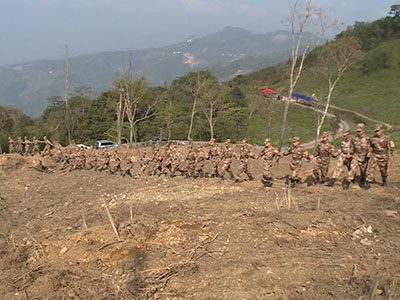
After the acceptance on foot, representatives of the mine-clearing forces and local governments at all levels signed the land transfer document, and the leaders of the mine-clearing forces announced that after the acceptance on foot, 4.436 square kilometers of peaceful land was returned to the hands of the masses.
At the end of the ceremony, military and civilian personnel jointly planted a number of saplings in the former minefield, hoping that the former minefield would become a fruitful orchard.

Up to now, the mine-clearing troops have cleared nearly 17 square kilometers of minefields along the Yunnan section of the Sino-Vietnamese border, and cleared more than 50,000 mines and explosives, accounting for 31% of the total task. Next, the officers and men of the Second Mine Clearance Team will be transferred to Maguan County, Wenshan Prefecture, and continue to fight in minefields such as Luojiaping Dashan and Dulong. It is planned to successfully complete all mine clearance tasks before the end of 2017. (CCTV reporter Yuan Bin Huang Qiao Hu Enkuan Li Zhenxing)

News link: Three major mine clearance in China-Vietnam border minefield
Since the 1990s, China has carried out three large-scale demining operations on the Sino-Vietnamese border.
Before the first large-scale mine clearance, thousands of residents in border areas were killed or injured because of mines, and the ports and passages on the front line of the border were blocked by minefields, which seriously affected border trade and cultivated land sowing.
In April 1992, China solemnly announced to the world that the Vietnamese government had taken the initiative to remove some mines on the Sino-Vietnamese border. The first mine clearance was carried out on the 1,353-kilometer border from the No.24 boundary pillar in Funing, Yunnan Province in the east to the 10-story mountain in Jiangcheng County in the west. It took 626 officers and men of six mine clearance teams two and a half years to complete the mine clearance of 108.2 square kilometers, remove more than 280,000 mines, more than 120,000 shells and grenades, and recover more than 2,400 boxes of unexploded ordnance.
On December 1, 1997, the second mine clearance began, and operations were carried out in Yunnan and Guangxi at the same time. 510 mine clearance team members carried out mine clearance tasks in 117 minefields of more than 1,280 kilometers, clearing a total minefield area of 109.67 square kilometers, removing more than 550,000 mines, restoring more than 138,000 mu of cultivated land and opening 52 border crossings. The second mine clearance ended in March 1999, which took two years and four months. At present, there are 6 national, 13 provincial border trade ports and more than 30 border trade points on the Sino-Vietnamese border.
The third Sino-Vietnamese border mine clearance began on November 3, 2015, and more than 400 mine clearance team members started operations in Yunnan and Guangxi at the same time. The task of this mine clearance is to completely remove 99 minefields with a total area of 55.59 square kilometers left over from the previous two mine clearance, and permanently enclose about 25 square kilometers of minefields. Up to now, the mine-clearing forces have cleared 40 minefields, covering an area of 17.67 square kilometers, accounting for 31% of the total task.